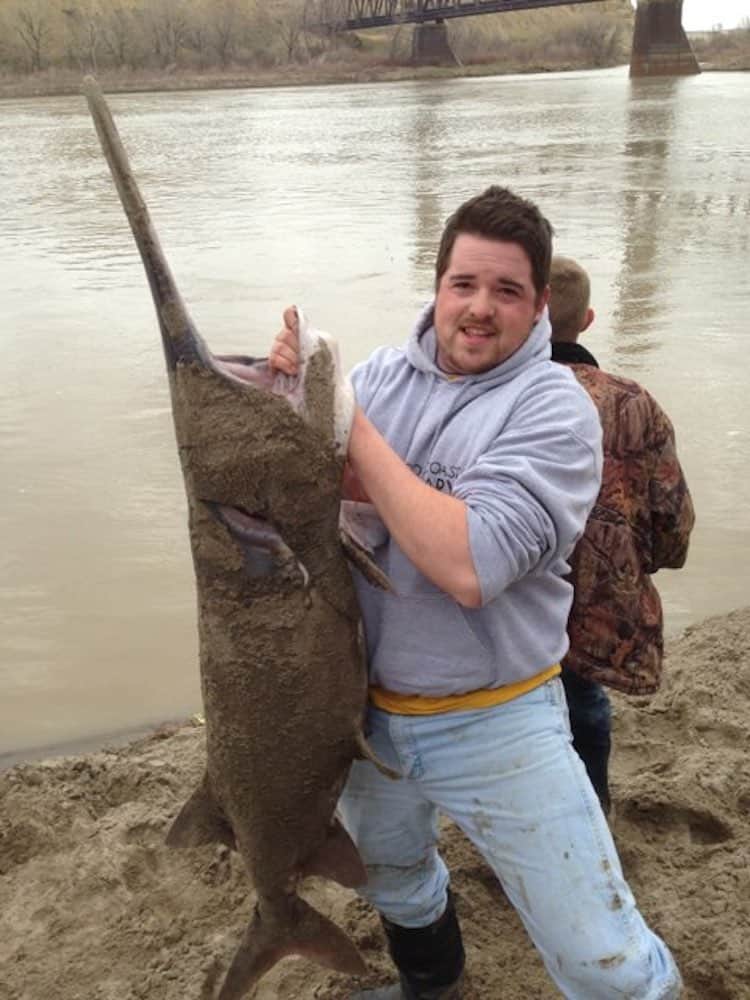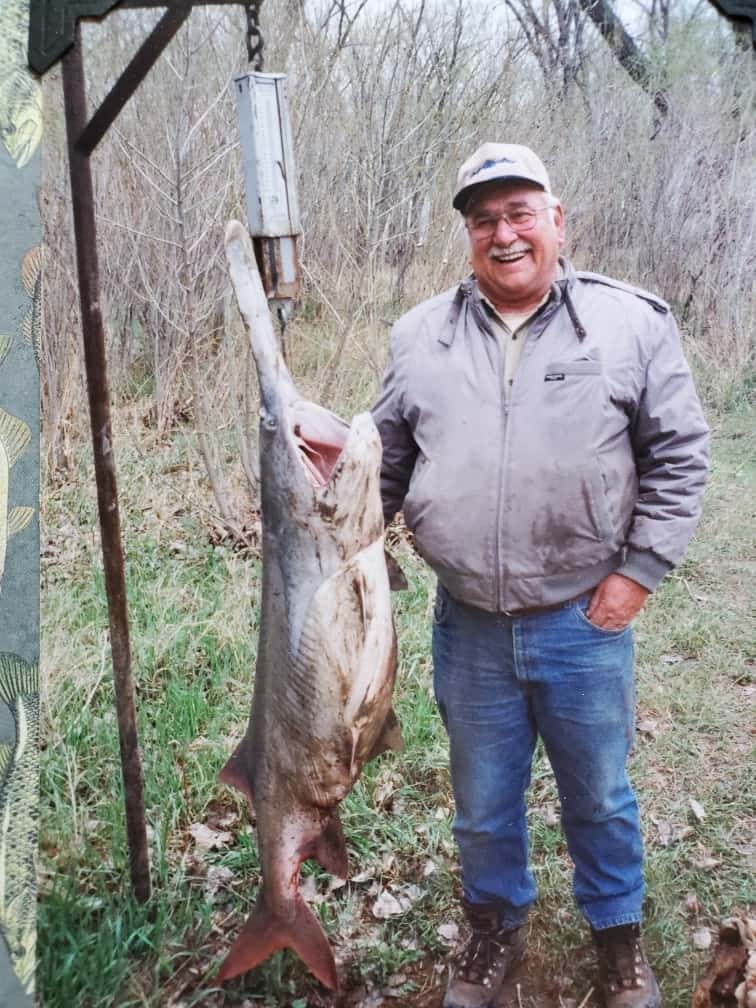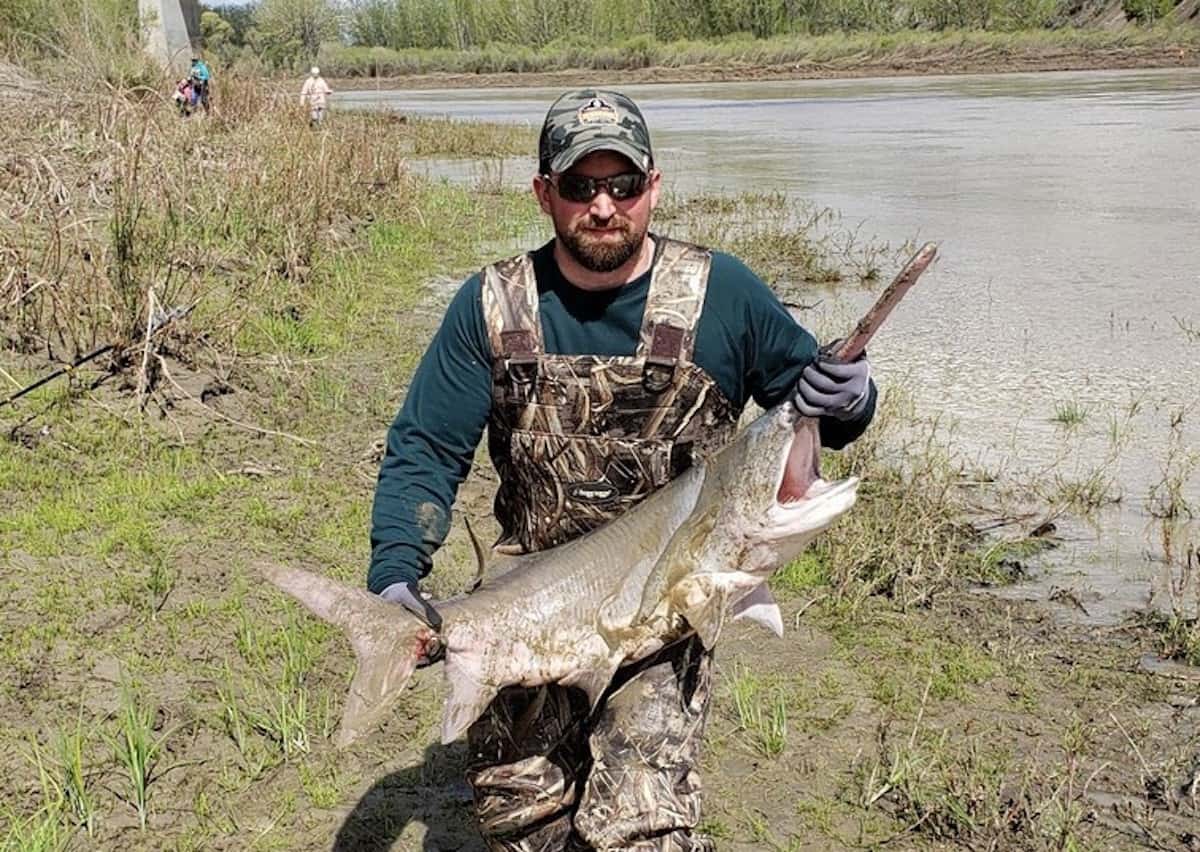Montana is known for having some of the best fly fishing in the world, especially when it comes to blue-ribbon trout streams.
What Montana is not as well known for is also being one of the last best places in the world to do battle with river monsters.
Yes, you read that right: river monsters.
One of those river monsters is the paddlefish, an odd-looking species that has been around some 65 million years and keeps a devoted corps of adrenaline junkies coming back to key Montana river banks each spring in hopes of snagging one of the prehistoric fish.
What the heck is a paddlefish, you ask?
A paddlefish (or spoonbill fish) is part of the sturgeon family. It lives up to its name with a shovel-like nose that makes up a third of its body length.
Paddlefish also have a thick skin of armor and can weigh as much as 150 pounds.
Paddlefish are strong and will put up a determined fight if you are lucky enough to snag one.
I personally had the opportunity to snag a paddlefish when I was just 8 years old, and the 60-pound fish at the other end of the line almost pulled me into the muddy Missouri River.
In fact that fish probably would have been successful if it weren’t for a friendly fisherman nearby who lent me a hand.
While Oklahoma produced the recent world record paddlefish, your odds may be better farther north. Montana has one of the largest populations of self-sustaining paddlefish in the U.S., but you have to know where to go, as well as when and how.
Anglers can take their chances in catching one in stretches of the Missouri and Yellowstone rivers.
In this article, we outline the best places for paddlefishing. However, before we give away our best fishing spots, let’s first take a look at how to catch one of these prehistoric monsters.
How To Fish For Paddlefish

Species like sturgeon and catfish will enjoy a nice worm floating along the muddy river bottom. It’s pretty easy to figure out what will get them on a hook.
In contrast, the paddlefish diet mainly consists of microscopic zooplankton. And if you are wondering, zooplankton doesn’t exactly go on a hook very well.
That makes snagging paddlefish with a treble hook the only way to catch these Jurassic fish. Unlike many other types of recreational fishing, snagging is a legal way to catch paddlefish as long as you’re following the rules.
In order to catch a paddlefish, you need a large pole (6-8 feet), 60- to 80-pound fishing line, and large, heavily weighted, barbless treble hooks (size 8/0 to 14/0).
Like most any other type of fishing, trying to catch a paddlefish is a numbers game. The only difference is, in paddlefishing the odds are not in your favor.
You can’t simply ask the local fishing shop what the fish are biting today.
Instead, you have to play the numbers. You toss out your treble hook and drag it across the river bottom as many times as it takes, improving your odds with each attempt.
If you are fishing from the shoreline, then the process is fairly straightforward.
The key here is to cast upstream as far as you can, and immediately after the hook hits the water, start reeling fast and jerk the pole to the side every 10 to 20 seconds.
If that’s tough to picture, check out this YouTube video of a fellow fisher snagging a paddlefish.
If paddle fishing from the bank sounds like too much work, there are other ways.
A primary way to snag a paddlefish is by trolling your hook behind a boat. This method doesn’t require the physical demands that shoreline fishing does.
Where to Catch Paddlefish
As mentioned, paddlefishing in Montana is limited to open parts of the Missouri and Yellowstone rivers, where these fish are abundant enough to allow a limited snagging season.
To narrow it down for you, here are two of the very best spots to land a paddlefish in Montana.
Intake Dam Fishing Access
One of the best-known places to fish for paddlefish in Montana is Intake Dam Fishing Access on the Yellowstone River.
Located 15 miles north of Glendive, this fishing access has been deemed by locals as the “Paddlefish Capital of the World.”
It got its name because each year when the run-off starts, large groups of paddlefish migrate out of the Missouri River into the Yellowstone River to spawn at the bottom of the diversion dam.
Even though the campground itself is 4 acres and hosts 40 campsites, it is usually filled for the entire month and a half of paddlefish season.
If you are serious about getting a chance to snag a spoonbill then the first key is to get a camping spot.
You likely will need more than one day to increase your odds of snagging one, so try and get to the fishing access during the week before the weekend crowd arrives.
Once you get a good camping spot, the next spot you need to get before the crowd arrives is a place on the shoreline. It won’t take long before the river bank will be lined with anglers dragging hooks across the river floor.
James Kipp Recreation Area and Campground
Approximately 70 miles south of Malta, James Kipp is a well-sheltered campground right on the Missouri River.
The area is popular for spring paddlefish season due to its 34 camping sites, public water, restrooms, fish clearing station and boat launch.
Paddlefish are caught at James Kipp each year, and the current state record paddlefish weighing 142.5 pounds was snagged here.
If you are shoreline fishing, the key is to go to Fred Robinson Bridge early in the morning and plant a chair because if the fishing is hot, it will be shoulder-to-shoulder before you know it.
People flood the shore by the bridge because this is one of few spots for casting and jerking long poles, but it’s still tough to find a good spot.
The river shore on the west end of the bridge has high cliffs, making it hard to cast. In addition, this section of the river isn’t very wide, which isn’t ideal for this type of fishing.
The east side of the bridge is the most ideal point to cast from but space is limited. The cottonwood trees quickly block out the shoreline, making many of the spots nearly impossible to throw out a line without snagging yourself on a branch.
James Kipp Campground is a well-maintained campground and a prime spot for paddefishing.
If you need supplies, Malta is the closest town to the north and Grass Range is about 45 minutes to the south.
When is Paddlefish Season in Montana?

Paddlefish season typically goes a bit longer than a month, starting around early to mid-May and ends in the middle to end of June.
Actually, there are several distinct paddlefish seasons.
There are two main paddlefishing seasons for rod anglers.
The upper Missouri River is run on a lottery basis to get a white harvest tag, while those who aren’t lucky enough to draw the white tag can still get one to do catch-and-release paddlefishing.
Another season is open in an area that includes parts of the Yellowstone and Missouri rivers.
There also is a bowfishing season for paddlefish in July and August.
The best approach is to study up on Montana’s paddlefish regulations every year, especially if you plan to meet the deadline (usually in March) to enter the drawing for a harvest tag for later that spring.
If you do end up getting a winning lottery ticket (a paddlefish keep tag), you will find that certainly doesn’t guarantee you will snag one. Each year the fish react differently depending on the run-off timing and water temperatures.
For example, in early May of a recent season, our group of five anglers snagged a total of four paddlefish on the Yellowstone River near Glendive. (Unfortunately, I was the only one in the group who didn’t snag one).
Then the same time the following year, we went to the Missouri River at James Kipp Campground and missed the peak of the paddlefish run by two weeks. Yes, we got skunked!
What I am saying is, put your ear to the ground and listen for word that fish are being snagged.
If you are talking to avid paddlefishers, you will inevitably hear about people catching 60- to 120-pounders somewhere along the Yellowstone and Missouri rivers.
Another good approach is to ask ahead of time at the Montana Fish, Wildlife & Parks if there has been any word on paddlefish being tagged.
They record every fish caught and tagged, and you might be able to get some insight from them or other anglers on what is the hot spot.
Can You Eat Paddlefish?
If you haven’t noticed, paddlefish aren’t the prettiest fish. However, that doesn’t mean they aren’t delicious fish to eat.
Paddlefish have been compared to catfish, although some paddlefishers say its better.
When a paddlefish is fileted, a lot of the fish itself is not edible. However, the 10 to 30 pounds of edible fish you get will make nice thick steak-like cuts.
The fish filets are similar to that of ahi tuna, thick and square.
Many popular paddlefishing areas offer free fish cleaning and fileting if you are willing to donate the caviar, which is often canned and sold.
Should You Try Your Luck Paddlefishing?
Paddlefish season in Montana will bring many frustrations, but it will bring even more memories.
The reward of you, a friend, family member or even a stranger snagging a paddlefish is more than worth the effort it takes to try and catch one.
When you hear or hopefully say to yourself, “Fish on!” you will know what I mean. The chaos of fishermen quickly reeling in their lines to watch the battle of man vs. fish is something to see.
Overall, paddlefish season brings a community of strangers together, all with one main goal in mind, to snag an elusive river monster.
Most will go home without hooking a paddlefish, but the chance to duel one of these prehistoric beasts will bring them back again next spring.
Patrick Davis is a freelance writer and Montana native who loves the outdoors, traveling and touring local craft breweries.

